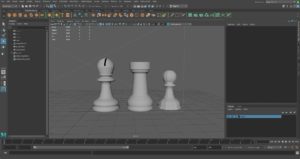3 Reasons Why You Should Cross-Train
Cross-training in game development is not only more respected than you may think, but it is expected among an array of concentrations. While specializing in a certain software or mastering a technique or aspect of your expertise is what you should strive for, there are 3 great reasons why you should cross-train to solidify your skill set.
Estalish clear communication.
When you can understand and speak the language of your neighboring departments, it clarifies the line of communication between teams. For instance, some artists may learn some programming to their repertoire of skills. 3D Animation & VFX for Film alumnus, Nathan Camp, learned Python while filming big-budget titles like Ready Player One and Avengers: Infinity War, and since then has become an asset to the Industrial Light & Magic team. This way of thinking can also be applied to programmers, who might see the benefits of learning Maya.
Work more efficiently.
If communication is clearly understood, this will naturally help increase the workflow of the pipeline. This is especially true when it comes to independent game companies – where a good majority of the staff will be expected to wear many hats. Let’s take quality assurance for example. Even if you don’t consider yourself an artist, having the ability to identify art-related errors in tandem of knowing what to look for in gameplay functionality, can be highly valued while testing an art-focused game. Otherwise, some issues with the art may go unnoticed, especially if that programmer doesn’t have a background in art.
You are more sought-after.
Studios around the world will be looking for a variety of things when they are looking to add to their roster. Most studios may require or prefer people who knows a foreign language, especially if you are looking for work in localization. Sometimes creators may want to explore further into what they are already comfortable with. 3D modelers or animators may be naturally inclined to learning how create storyboards, or designing the UI (user interface) in a game. A great example of this would be one of our 1st year students, Peter Neill (Game Art & Animation), who has found a natural segue in learning the technical aspects of 3D Art, after years of creating storyboarding and animatics.
How should I approach cross-training?
Committing to learn a new skill, even if you are just learning the basic concepts, can prove to be a daunting task, but proven worth the time. You don’t have to learn Maya or a programming language extensively (unless you want to!), but you may even find it beneficial to understand just the basics. Finding a mentor with this expertise can teach you their ways, or taking a short introduction course can come in handy for those who would like to learn in a more structured setting. Whether you are learning VFX to supplement your background in cinematography or video editing, or maybe learning Python to become a well-rounded Technical Artist, cross-training has no drawbacks.


